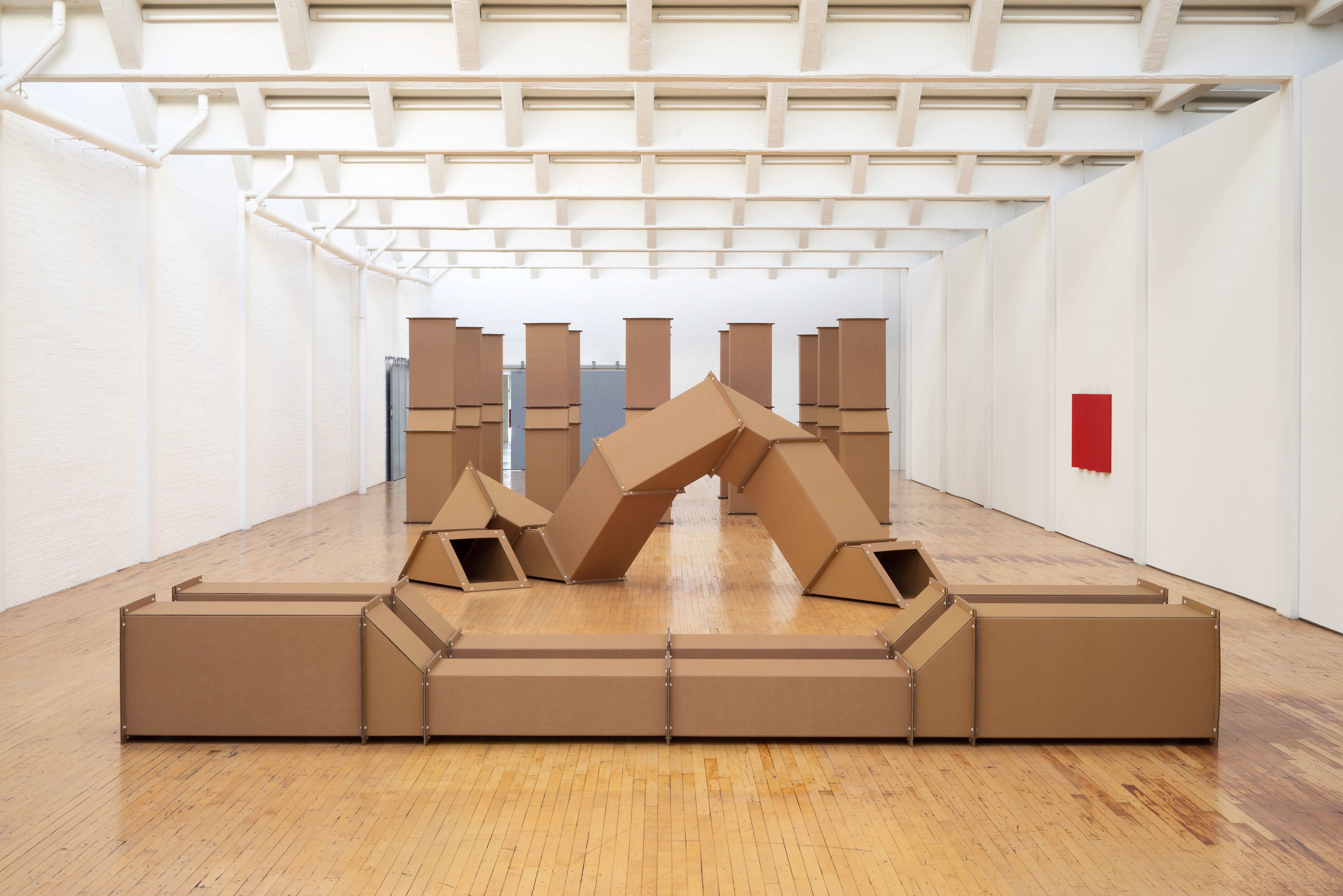
In an art career spanning just 12 short years, German artist Charlotte Posenenske (1930–1985) earned herself a place in the pantheon of great Minimalist artists—and New York’s Dia Art Foundation is making sure everyone finally knows it by staging her first large-scale stateside exhibition at Dia:Beacon.
The show, centered around the foundation’s recent acquisition of 155 of Posenenske’s late sculptural works, is part of Dia director Jessica Morgan’s efforts to expand the narrative of Minimalist art beyond the white male practitioners with whom it is most associated.
“What happens with [Donald] Judd and [Dan] Flavin and all the big guys is 100 percent an important and interesting part of our history, but other work was happening along side it at the same time, and deserves just as much recognition,” said associate curator Alexis Lowry during a tour of the exhibition. “We want to augment and expand [how we talk about] that particular moment when people are thinking about seriality, geometric abstraction, and monochromatic coloring.”
Posenenske, in particular, was a good fit for Dia because the exhibition is staged “alongside the peers that she showed with in her lifetime,” said Lowry. “To re-situate her in that context shows how radical she was.”
“Charlotte Posenenske: Work in Progress,” installation view, Dia:Beacon, Beacon, New York/Estate of Charlotte Posenenske, Frankfurt. Photo by Bill Jacobson Studio, New York.
In the show, Posenenske’s newly acquired factory-fabricated modular sculptures are supplemented with loans of the artist’s early works on paper, including examples of her theatrical set and costume designs. “The exhibition traces the full evolution of her practice,” said Lowry.
The pivotal point in Posenenske’s career came in 1966, as the next step after sculptural drawings that bent or creased the page. “She decides she’s going to pare down, simplifying her forms,” said Lowry. “She’s going to stop making unique, individual objects by hand for ownership, and she’s going make schematic drawings for objects she can have industrially fabricated.”
All of these objects could be changed and manipulated at home, arranged however the “consumer” (as Posenenske dubbed her collectors) saw fit.
“There’s a sense of minimizing her own authorial role to privilege that of the participants,” said Lowry.
These serially produced objects make up the bulk of the Dia exhibition, specifically the repetitive curved and angled metal panels in primary colors—red, yellow, blue, and black—of her “Series A,” “Series B,” and “Series C.”
Charlotte Posenenske,Reliefs Series C (1967). Installation view, Dia:Beacon, Beacon, New York. Daimler Art Collection, Stuttgart/Berlin. Estate of Charlotte Posenenske, Frankfurt. Photo by Bill Jacobson Studio, New York.
For “Series D,” Posenenske developed a set of six shapes, all of which look exactly like galvanized steel ventilation ducts, and are produced in a factory that makes the real deal. The related “Series SW” recreates four of these shapes in corrugated cardboard.
These works are currently configured based Posenenske’s drawings, but at two points during the exhibition’s run, the curatorial team will rearrange all the pieces, working during regular visiting hours to come up with a new design.
Though Posenenske’s pieces are still in production today, it’s possible to distinguish the newer works from the older ones, which bear the patina of age. In addition, “the techniques for galvanizing steel have changed,” said Lowry, comparing the smooth, uniform surface of the newest pieces to the speckled finish on older works. “Even in the last three or four years the process has really been refined.”
Charlotte Posenenske, Vierantrohr (Square Tube), Series D (1967), installation view, Gallery Mehdi Chouakri, Berlin (2008). ©Estate of Charlotte Posenenske. Photo by Jan Windszus, Berlin, courtesy Estate of Charlotte Posenenske, Mehdi Chouakri, Berlin and Peter Freeman, New York.
Posenenske’s final works in “Series E” take the concept of mutability even further. The architectural structures feature movable hinged panels on vanes that viewers are invited to push and pull, rearranging the piece at will. Dia has even fabricated one of the artist’s designs for her first time for the show, a large, low wall that can spin 360 degrees on its axis, bisecting the gallery.
“The office cubicle is introduced in the mid-60s,” Lowry pointed out. “It’s like this is her way of resisting the cubicle: ‘I’m going to take this standard architecture and blow it apart.'”
“Charlotte Posenenske: Work in Progress,” installation view, Dia:Beacon, Beacon, New York/Estate of Charlotte Posenenske, Frankfurt. Photo by Bill Jacobson Studio, New York.
This creative outburst came to an abrupt halt in 1968. At that time, Posenenske completely reinvented herself as a sociologist, giving up her art completely to focus on industrial labor and advising unions. Then, in 1984, the year before her death, sick with cancer, she gave careful thought to her artistic legacy. With her second husband, Burkhard Brunn, Posenenske put her work back into production, authorizing her estate to sell modern reconstructions of her sculptures.
The original piece in the 1960s are now considered “Prototypes,” and are only available for purchase by public institutions. The works in continuous production aren’t numbered or editioned. They are still sold at the cost of production plus overhead—Posenenske’s way of limiting the resale value for her work, and opting out of the commercial art market.
Charlotte Posenenske, Square Tubes Series DW (1967/2018). Installation view, Dia:Beacon, Beacon, New York. Daimler Art Collection, Stuttgart/Berlin. Estate of Charlotte Posenenske, Frankfurt. Photo by Bill Jacobson Studio, New York.
“Posenenske was definitely at the precipice of a major international career,” said Lowry. “She was conscious of the fact that she might have a legacy, and she wanted it to be deliberate.”
“Charlotte Posenenske: Work in Progress” is on view at Dia:Beacon, 2 Beekman Street, Beacon, New York, March 8–Sept. 9, 2019. The exhibition will travel to the Museu d’Art Contemporani de Barcelona in Spain, Kunstsammlung Nordrhein-Westfalen Düsseldorf in Germanym and Mudam Luxembourg—Musée d’Art Moderne Grand-Duc Jean in Luxembourg.